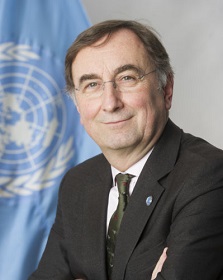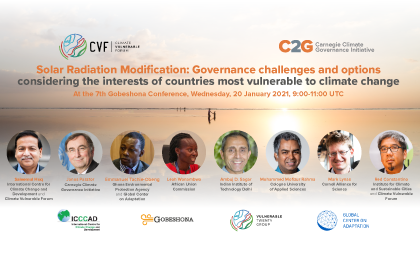Refocusing C2G on catalysing the governance of
Solar Radiation Modification

In late February, UN Climate Change (UNFCCC) revealed that 75 Parties which had submitted new or updated commitments under the Paris Agreement – representing 30% of global greenhouse gas emissions – fell far short of the 45% cut needed to limit global warming to 1.5°C.
UN Secretary-General António Guterres called it “a red alert for our planet”, saying it showed governments were “nowhere close to the level of ambition needed” to limit climate change to 1.5°C and meet the goals of the Paris Agreement.
Five years after Paris and despite the growing number of countries committing to net zero by around 2050, the world today is simply not following through with the radical emissions cuts it needs to avoid disaster.
In that context, we now increasingly see discussions about large-scale Carbon Dioxide Removal (CDR) – the idea that as well as cutting emissions, humanity also needs to remove billions of tonnes of CO₂ already in the atmosphere.
These discussions are taking place within and amongst governments, civil society organisations, and the private sector. Nature-based approaches are receiving priority attention, but new technologies are also fast rising up the agenda, as realisation grows that no single approach will deliver the amount of removal required.
The world faces tough choices to keep warming below 1.5°C. It needs to radically cut emissions and also identify and deploy approaches to remove carbon from the atmosphere.
These choices raise many issues, including for sustainable development. For the past four years we have been alerting people to the challenges, the governance gaps, and kick-starting conversations to tackle them.
But as we see more players now getting into this topic, from various parts of the world, C2G’s mission to catalyse the creation of effective governance of large-scale CDR is being met, and our added value in this space is declining.
To that end, the time has come for C2G to focus increasingly on catalysing the creation of effective governance for Solar Radiation Modification (SRM) [1].
Why can C2G start stepping back from CDR governance?
It is important to note that C2G is not saying that governance of large-scale CDR is yet sufficient – either at national or at international levels.
Knowledge remains limited, and many governance gaps remain. For a more in-depth discussion, read our updated report Governing large-scale carbon dioxide removal: are we ready?, and also our new evidence brief on large-scale CDR.
But C2G’s aim was always contained: our job was to plant the seeds, to encourage others to get into this space, and then to step back.
For example, one project we have been working on is to support governments to discuss, in an informal setting, their practical experience of large-scale CDR. This includes sharing experiences around technology and financing, and how to address synergies and trade-offs with sustainable development objectives. With that process now underway, our role there is nearing its end.
This does not mean we will not talk about CDR from time to time, in particular to support those who have engaged with C2G on this challenge.
Responses to climate change need to be considered in their totality – including emission reductions, CDR and adaptation. These include considering how to deal with, if possible, the risks of not being successful in reaching the Paris goals (more on that in the next section).
But the bottom line is that we are wrapping up our primary activities on large-scale CDR governance, and plan no new ones.
The time has come for others who have picked up the baton – in action and in spirit – to address the governance gaps.
Why Solar Radiation Modification governance now?
Governance is the process that allows societies to deal with new and emerging challenges.
One of the current challenges is to understand and prepare for the possibility that the world might not achieve sufficient emission reductions and carbon dioxide removal to keep temperatures to 1.5°C, and what that scenario will mean in terms of impacts, adaptation needs – and what approaches, if any, may or not be available to deal with such temperature overshoots.
In that context, there is growing research into a set of techniques known as Solar Radiation Modification, which would aim to reduce the Earth’s temperature by reflecting more sunlight back into space, or by allowing more infrared radiation from the Earth to escape.
Those are not new ideas. The Intergovernmental Panel on Climate Change (IPCC) covered them in previous assessments, and governments asked it to do so again in its forthcoming 6th assessment. You can learn more about SRM approaches on our website; and how they raise difficult questions about who would take decisions, where, and on what basis.
But while many actors are starting to enter the large-scale CDR governance space, this is not the case for SRM.
Some think that talking about SRM is premature, or they may be reluctant to do so for various reasons, including that considering these ideas at all is to think the unthinkable.
However, others see a lack of SRM governance as a risk in itself, and one which is rising as more actors explore what options might be available (or not) to reduce the risks of overshooting temperature goals.
In 2016, for example, parties to the Convention on Biological Diversity noted that “more transdisciplinary research and sharing of knowledge among appropriate institutions is needed to better understand the impacts of climate-related geoengineering on biodiversity and ecosystem functions and services, socio-economic, cultural and ethical issues and regulatory options”.
Today a number of activities are heightening this need for governance.
Australia has been exploring the potential for marine cloud brightening to protect the Great Barrier Reef. The Arctic Ice Project is looking to “enhance the Arctic’s natural ability to reflect solar radiation out of the atmosphere, increase the Earth’s planetary albedo, and slow the rate of global warming.”
SilverLining last year announced a USD 3 million research fund to advance efforts to study SRM. The US Congress previously gave the National Oceanic and Atmospheric Administration USD 4 million for similar research. The Solar Radiation Management Governance Initiative (SRMGI) established the Decimals fund to help researchers explore SRM from the Global South.
On the 25th of March, the US National Academies of Sciences Engineering and Medicine is expected to release a “Research Agenda and Research Governance Approaches for Climate Intervention Strategies that Reflect Sunlight to Cool Earth”.
And as of writing, there is growing focus on whether the Stratospheric Controlled Perturbation Experiment (SCoPEx) by the Keutsch Group at Harvard University – which aims “to advance understanding of stratospheric aerosols that could be relevant to solar geoengineering” – should go ahead with a planned experiment in Sweden in June.
It is not C2G’s role to take a position on whether research into SRM should happen or not, but we do see these developments as requiring wider attention, learning, discussion, public policy guidance and potentially regulation – in other words, governance.
It’s important to clarify however, that there is a difference between advocating for the governance of something, or for the thing itself.
In this case, we see that an idea – SRM – is receiving increasing attention from parts of society, but not others. It is not for us to advocate or not whether it should be explored further, but seeing that it is being explored, our view is that it needs governance.
Commentators in the Global South are already questioning why the Global North should determine the evolving frameworks for governance, and are insisting they be part of this debate.
“Whatever threats geoengineering or SRM poses … the biggest threat is that the vulnerable countries are out of this discussion and that this comes too late to their plates,” said Red Constantino, Deputy Co-Chair of the Climate Vulnerable Forum (CVF) Expert Advisory Group, at the Gobeshona Global Conference in January.
Without sufficient international governance, the risk of leaving some stakeholders behind is increased. Frames and patterns established now are likely to set the stage for decades.
To that end, the time to get involved in SRM governance is now. This is true whether one can see a future or not for such approaches. The best time to decide where the bus is going is before it leaves the depot. So please do stay with us on this journey, as we seek to expand this conversation.
_______________
[1] Also referred to as solar radiation management, solar geoengineering, solar climate intervention, or sometimes simply geoengineering.


